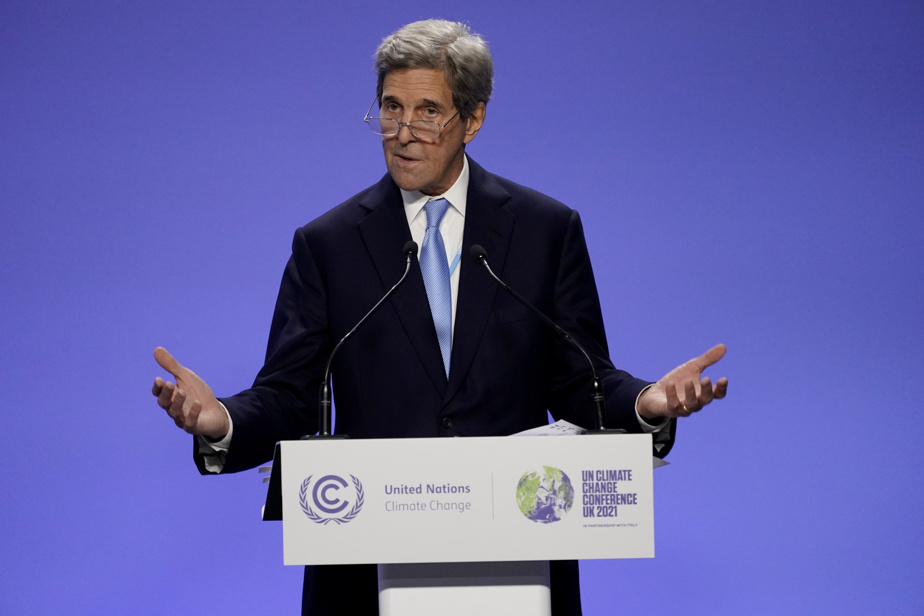Two days before the conclusion of COP26, in Glasgow, Scotland, the United States and China issued a joint statement pledging to take concrete action by 2030 to reduce global warming to 1.5 degrees by the end of the century.
Eric-Pierre Champagne Journalism
The announcement comes the day after the publication of a draft of a possible final declaration for the international conference, which ends on Friday. A more ambitious text, but still considered insufficient.
The stakes are high since the British presidency of COP26 made the goal of limiting global warming to 1.5°C one of the key signs of the conference’s success.
In their joint statement, the United States and China privately stated that they wanted to “continue efforts to limit the temperature to 1.5°C.” [la hausse des températures] and a commitment to continue these efforts, including taking ambitious steps during this critical decade to keep the above temperature limit within reach, including, if necessary, connecting or updating CDNs [contribution déterminée au niveau national] 2030 and long-term strategies.
The preliminary text of the COP26 Final Declaration also asserts that “the impacts of climate change will be significantly lower with a warming of 1.5°C, compared to 2°C.” But the commitments made so far at COP26 still put the world on a path of 2.7°C warming by the end of the century.
Countries are invited to “review and consolidate” their Nationally Determined Contributions from 2022 that have set out their short-term commitments in order to limit global warming to 1.5 degrees by 2100.
This draft elicited mixed reactions. It will also be necessary to know what will be retained in a possible final declaration which in principle should be adopted by consensus. COP 26 ends on Friday.
The document calls for “rapid, sharp and sustainable reductions in global greenhouse gas emissions, including reductions in carbon dioxide emissions.”2 45% in 2030 compared to the 2010 level and carbon neutral by mid-century.”
Notably, the text also encourages countries to “accelerate the phase-out of coal and fossil fuel financing,” which are responsible for most of the emissions.
Such an explicit reference to fossil fuels is unprecedented, and does not particularly appear in the Paris Agreement. But it promises to be bitterly contested until the final text is finished.
And in another burning issue, “the text notes with regret the failure of developed countries to deliver on their promise to mobilize about $100 billion annually in climate financial assistance from 2020 to poor countries, which are often the least polluting, but most vulnerable to the effects of climate change.”
However, it does not offer a clear solution to achieving this goal, which rich countries now guarantee they can achieve from 2023, according to the new “delivery plan”.
But he is calling for donors to double funding for “adaptation” measures to the effects of climate change, which currently accounts for only a quarter of that assistance, compared to 75% to cut emissions. Poor countries claim at least parity between the two components.
mixed reactions
Initial reactions were mixed, as the Climate Vulnerability Forum (CVF), which represents more than 1 billion people from 54 countries, estimated that the text “does not meet the main demands of countries at risk”. and calling for an “emergency pact” that includes real measures to contain global warming and “ensure the delivery of promised funding.”
AOSIS described the text as “a basis for progress (which) needs to be strengthened. […] in particular to meet the needs of the most vulnerable”, including the specific “Loss and Damage” envelope.
For Jennifer Morgan, Director of Greenpeace International, “This is not a plan to solve the climate crisis, but rather an agreement to cross your fingers in the hope that it will be okay. A polite request to countries to do more, if possible, in the next year. It is not enough. “.
For Mohamed Addo, director of the Power Shift Africa Study Center, “There is a lot about acceleration in reducing emissions, but very little about the main demands of poor countries.”
Le WWF (Fonds mondial pour la nature) s’est félicité de l’appel à réviser des plans de réduction et de la mention faite des énergies fossiles, mais a souligné que ce texte devait « être un plancher, pas un plafond » avec des points for improvement.
with AFP





